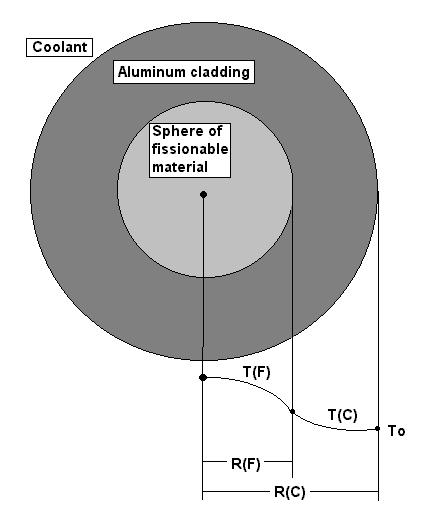
This section of Bird,
Stewart, and Lightfoot examines heat conduction in a spherical nuclear
fuel element. It consists of a fissionable material, the heat source,
with a radius RF, surrounded by a sphere of aluminum cladding with an outer
radius of RC (see figure), and an outer temperature of To. I begin by defining
the source of thermal energy, Sn and then derive expressions for the heat
flux in the fissionable material, the heat flux in the cladding, the temperature
profile in the cladding and the temperature profile in the fissionable
material.

The Maple derivation of the equations:
Section 9.3 -- Heat Conduction with a Nuclear Heat Source
> restart;
> Sn:=r->Sno*(1+b*(r/RF)^2);
This
is equation 9.3-1
![[Maple Math]](images/juancor1.gif)
> A:=r->4*Pi*r^2;
Area
of the shell around which the balance is being made.
![]()
> Q:=r->q(r)*A(r);
General
expression for thermal energy.
![]()
> lefths:=limit((Q(r+dr)-Q(r))/dr,dr=0);
![]()
> de:=lefths=Sn(r)*A(r);
Equivalent
to equation 9.3-6.
![[Maple Math]](images/juancor5.gif)
> cladding:=lefths=0;
This
is the expression for thermal energy in the cladding, in which there is
no source of nuclear energy.
![]()
> sol:=dsolve({de,q(0)=finite},q(r));
This
solves the first differential equation with the constraint that at r=0,
q is not infinite (eq. 9.3-10).
![[Maple Math]](images/juancor7.gif)
> assign(sol);qf:=unapply(q(r),r);
This
is the flux in the fissionable material.
![[Maple Math]](images/juancor8.gif)
> book93_12:=Sno*(r/3+b*r^3/(RF^2*5));
![[Maple Math]](images/juancor9.gif)
> simplify(book93_12-qf(r));
This
means that qf(r) agrees with equation 9.3-12 in the book.
![]()
> q:='q';
![]()
> sol2:=dsolve({cladding,q(RF)=qf(RF)},q(r)); This solves differential equation in the cladding with the constraint that the two fluxes be equal at the boundary of the cladding and the fissionable material (eq. 9.3-11).
![[Maple Math]](images/juancor12.gif)
> assign(sol2);qc:=unapply(q(r),r);
![[Maple Math]](images/juancor13.gif)
> book93_13:=Sno*RF^3*(1/3+b/5)/r^2;
![[Maple Math]](images/juancor14.gif)
> simplify(book93_13-qc(r)); This shows that the expression for qc(r) agrees with that in the book.
![]()
> Fourier1:=-kF*diff(TF(r),r)=qf(r);
Fourier's
law of heat conduction applied to the sphere of fissionable material.
![[Maple Math]](images/juancor16.gif)
> Fourier2:=-kC*diff(TC(r),r)=qc(r); This is Fourier's law of heat conduction applied to the cladding.
![[Maple Math]](images/juancor17.gif)
> sol3:=dsolve({Fourier2,TC(RC)=To},TC(r));
Solving
this differential equation with the boundary condition that at the outer
edge of the cladding the temperature is To (eq. 9.3-19).
![[Maple Math]](images/juancor18.gif)
> assign(sol3);TC:=unapply(TC(r),r);
An
expression for the temperature in the cladding.
![[Maple Math]](images/juancor19.gif)
> righths:=simplify(TC(r)-To);
An
expression for the temperature profile.
![[Maple Math]](images/juancor20.gif)
> book93_21:=Sno*RF^2/(3*kC)*(1+(3*b/5))*((RF/r)-(RF/RC));
![[Maple Math]](images/juancor21.gif)
> simplify(righths-book93_21); This agrees with the expression in the book (eq. 9.3-21).
![]()
> sol4:=dsolve({Fourier1,TF(RF)=TC(RF)},TF(r)); This solves the differential equation given by Fourier's law of heat conduction in the fissionable material with the boundary constraint that the temperature at the boundary of the cladding and the fissionable material be the same (eq. 9.3-18).
![[Maple Math]](images/juancor23.gif)
![]()
> assign(sol4);TF:=unapply(TF(r),r); An expression for the temperature in the fissionable material.
![[Maple Math]](images/juancor25.gif)
![]()
> Righths:=simplify(TF(r)-To); An expression for the temperature profile (comparable to 9.3-20).
![]()
![]()
> book93_20:=Sno*RF^2/(6*kF)*((1-(r/RF)^2)+3/10*b*(1-(r/RF)^4))+Sno*RF^2/(3*kC)*(1+(3/5*b))*(1-(RF/RC));
![[Maple Math]](images/juancor29.gif)
> simplify(Righths-book93_20); This shows that the answer agrees with equation 9.3-20.
![]()